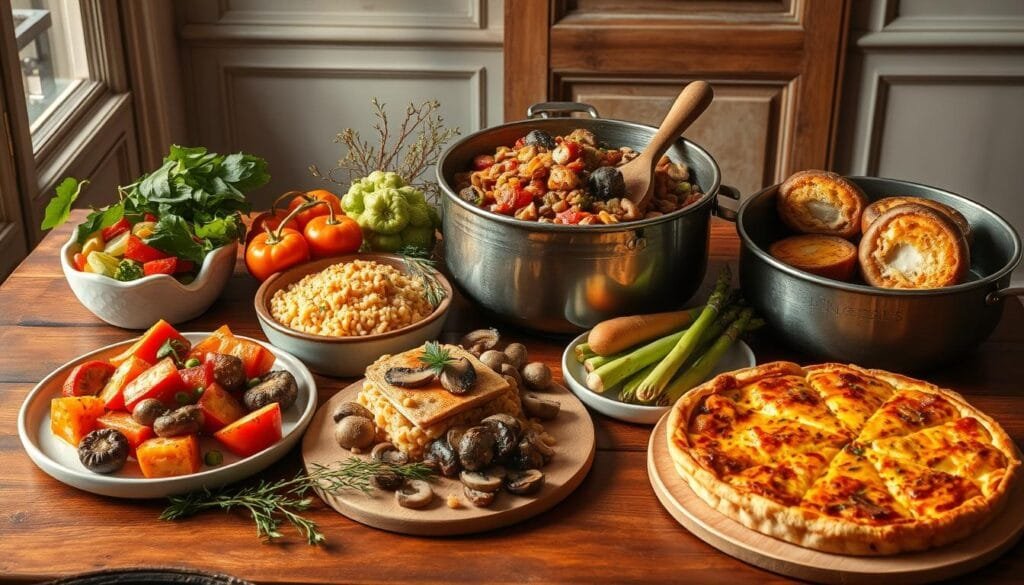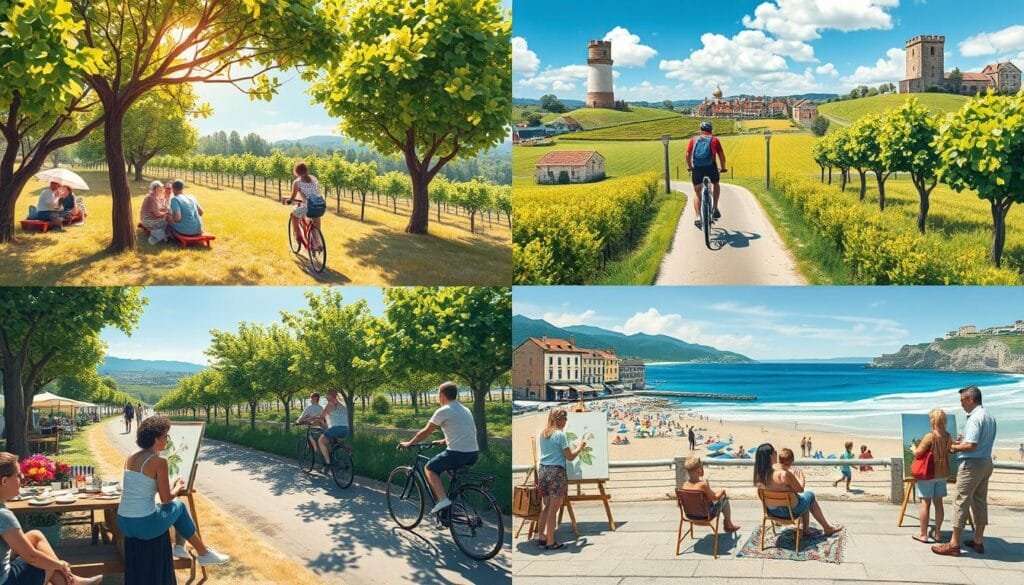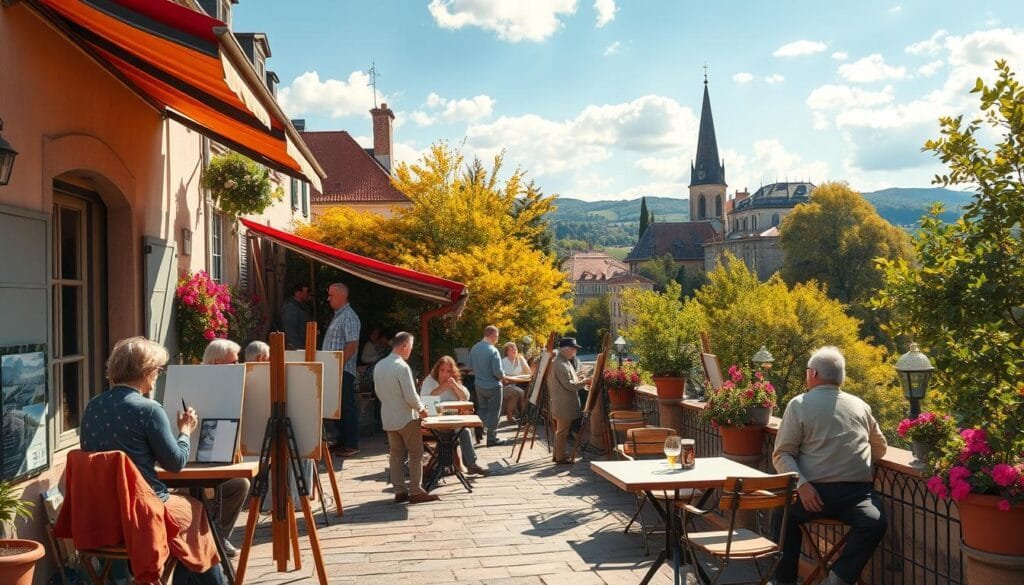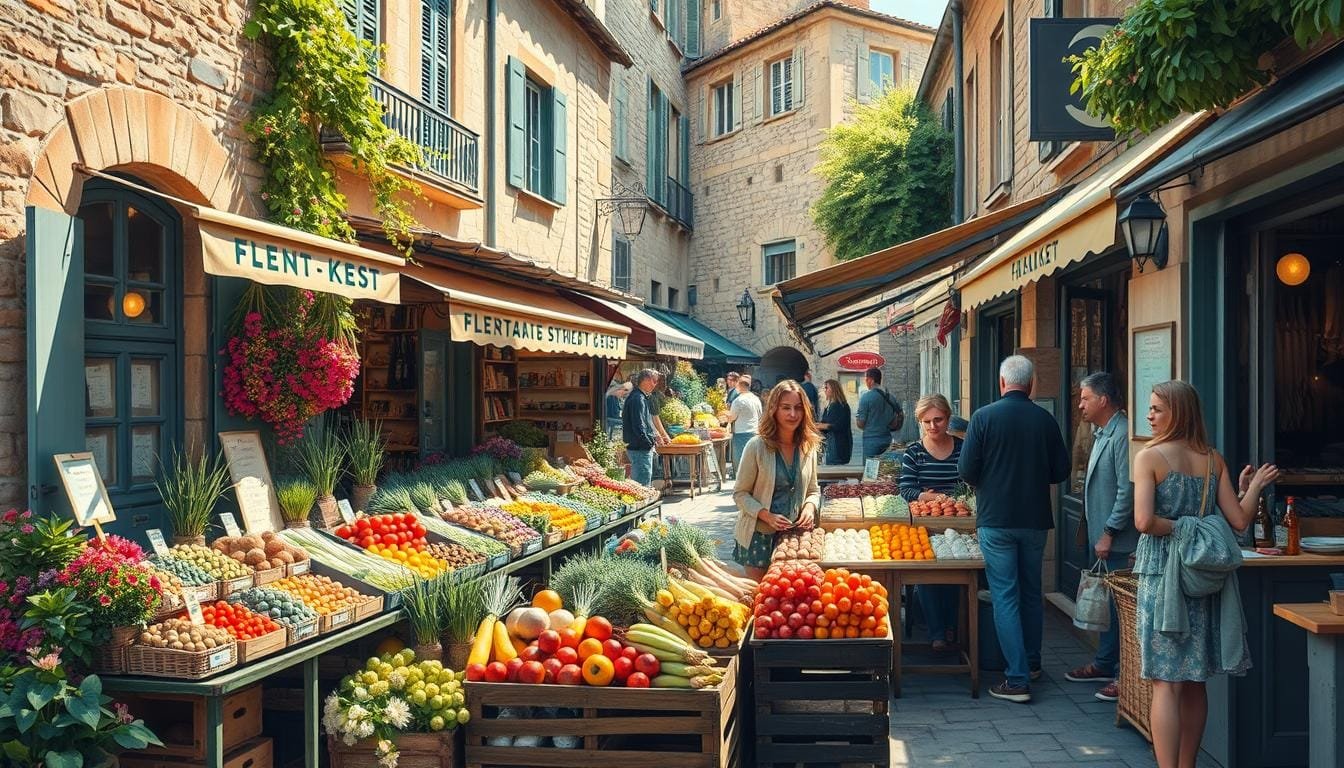How does the diverse climate in France leave a lasting imprint on its cultural landscape?
From the romantic whispers of the winds in Paris to the sun-soaked vineyards of Bordeaux, climate shapes French culture deeply. It might not be clear at first, but climate touches everything from the diverse culture to daily life. Let’s see how France’s varied climates play a key role in tradition, cuisine, and art, enchanting both locals and visitors.
Understanding climate and culture together shows us the beauty of French life. It also highlights the French’s adaptability and creativity. We’ll explore how weather affects regional foods, building styles, and stories in art and literature.
Key Takeaways
- French cultural diversity is significantly influenced by the country’s varied climates.
- Regional cuisines and seasonal dishes reflect local climatic conditions.
- Festivals and traditions are often shaped by seasonal weather patterns.
- Architectural styles in France respond to practical climate considerations.
- Climate settings often influence the mood and themes in French art and literature.
For a deeper understanding of how climate intricately weaves through the fabric of French culture, from the towering cathedrals of Paris to the rustic kitchens of Provence, visit this comprehensive guide.
Introduction to the Varied Climates of France
France boasts a variety of climates. This diversity shapes local culture, environment, and ways of living. We will explore the France climate zones, from warm coasts to cold interiors.
Overview of Climate Zones
France has many climate zones, such as oceanic, continental, and Mediterranean. It stretches across different latitudes, from 41° 19′ N to 51° 04′ N. This range impacts everything from farming to traditions.
High places like the Alps and Pyrenees get a lot of rain and snow. This adds to the France climate zones diversity.
The Impact of Oceanic Climate
In places like Brittany and the Atlantic coast, the weather is mild with a lot of rain. For example, Brest’s weather in January averages at 43 °F and 61 °F in July. The oceanic climate impacts farming, helping produce various crops and lush fields.
Influence of Continental Climate
The east and center of France have a continental climate in France, with cold winters and warm summers. Strasbourg sees around 83 frost days in winter. This climate benefits wine growing, making famous vineyards possible.
Paris combines urban charm with the beauty of changing seasons. It averages 53 °F year-round with about 23 inches of rain.
Mediterranean and Mountain Climates
The southeast of France enjoys a Mediterranean climate influence. Here, summers are hot and dry, winters mild and wet. Nice, for instance, has an annual average temperature of 59 °F with little rain in places like Languedoc-Roussillon.
Snow stays in the Pyrenees from December to late April over 3,000 feet. This weather pattern supports diverse coastal and mountain lifestyles. They greatly enrich France’s culture.
| Region | Climate | Average Annual Temperature | Annual Rainfall |
|---|---|---|---|
| Brittany | Oceanic | 52 °F (11 °C) | 35 inches (890 mm) |
| Paris Basin | Continental | 53 °F (11 °C) | 23 inches (58 cm) |
| Nice | Mediterranean | 59 °F (15 °C) | 20 inches (500 mm) |
| Pyrenees | Mountain | Varies with Altitude | 50 inches (1,270 mm) |
Influence of Climate on French Cuisine
The climate in France greatly shapes its food culture. This creates a unique culinary tradition. Different regions offer various ingredients and dishes. These celebrate France’s diverse weather.
Regional Variations in Ingredients
France’s weather leads to special local foods. For example, Normandy’s moderate weather produces 1.5 million tons of apples each year. This results in famous dishes like Poulet Vallée d’Auge. In contrast, Provence enjoys hot summers perfect for herbs and vegetables. These make up about 30% of local recipes.
| Region | Climate | Key Ingredients |
|---|---|---|
| Normandy | Temperate | Apples, cream, butter |
| Provence | Hot, dry | Herbs, tomatoes, olive oil |
| Bordeaux | Oceanic | Grapes (wine), seafood |
| Burgundy | Continental | Mustard, wine, beef |
Seasonal Dishes and Celebrations

French chefs love using local, seasonal ingredients. About 75% of them do so. This choice boosts flavors and supports sustainable practices.
Seasonal events highlight certain ingredients. Less rain and higher heat impact the Périgord truffles, a winter favorite. Moreover, about 20% of dishes feature wine from Bordeaux or Burgundy.
Traditions and festivals combine climate with French culinary arts. They showcase the need to adapt to the environment. At the same time, they preserve France’s rich food heritage.
How Does the Climate in France Affect the Culture
The climate in France deeply influences its culture. It affects festivals, traditions, architecture, and outdoor activities. This shows that French culture is shaped not just by history, but also by the weather.
Festivals and Traditions Shaped by Weather
In France, the weather plays a big role in its festivals and traditions. The “Fête de la Musique” happens on June 21st. This date matches the summer solstice, making it great for outdoor music.
The “Fête des Vendanges” in Paris celebrates grape harvesting in early autumn. The weather then is just right for such celebrations. Another event, the “Battle of the Flowers” in Nice, takes advantage of the mild winter there. These events show how French traditions are linked to the nation’s weather.
Architectural Styles Responding to Climate
The architecture in France varies with the climate. In colder areas like Alsace, houses have steep roofs for snow. But in the Mediterranean area, buildings are made to stay cool during hot summers.
This adaptation in building styles reflects the climate’s influence on France’s architecture. This creates a rich variety of buildings that are both beautiful and practical.
Outdoor Activities
France’s climate allows for many outdoor activities. Brittany’s weather is perfect for sailing all year. The French Alps offer skiing and snowboarding in winter.

People in France also enjoy hiking in the Pyrenees or cycling in Provence. These activities are all possible because of the diverse climates in France. This makes the country an ideal spot for adventure lovers.
Climate change is affecting these activities in France, as noted in the climate change in France report. This highlights the ongoing link between the French climate and its culture.
Climate’s Role in Shaping French Art and Literature
France’s diverse climates have deeply influenced its art and literature. The oceanic climate of the coast and the Mediterranean warmth of the south have shaped French culture. Their effects are seen in the artworks and writings, showing the link between weather and expression.
The Depiction of Landscape in Art
French art vividly displays the influence of different climates. The Impressionists, like Claude Monet and Edgar Degas, were inspired by France’s landscapes. The west’s mild climate helped them capture light and water beautifully, such as in Monet’s water lilies.
The south’s sunny climate provided a perfect scene for many outdoor artworks. This range of weather has been key to creating famous masterpieces.

Weather and Mood in Literature
Climate also shapes the mood in French literature. Authors like Victor Hugo and Marcel Proust included climate’s effects in their stories. The cold northeastern winters bring reflective moods to books, while the Pyrenees’ air brings out stories of freedom.
Climate doesn’t just influence the setting but also affects themes and characters. This adds depth and authenticity to the stories, making them more engaging.
Overall, the interaction of climate and landscape is key to French art and literature. It celebrates the rich variety of nature’s expressions in culture.
Conclusion
In studying France’s climate and culture, we see how weather shapes food, festivals, and art. The west’s oceanic climate brings fresh seafood to the table. Meanwhile, the Mediterranean’s warmth aids in growing olives and making wine. Thus, regional climates shape France’s food culture.
Seasonal ingredients influence menus and spark celebrations and traditional events. This shows how deeply weather is woven into France’s cultural fabric.
Climate also changes how people build and live. Different weather leads to unique architectural styles. For example, sunny south France has villas, while the mountains have stone buildings. This variety reflects not just in homes but in outdoor activities, like Nice’s Mardi Gras or skiing in the Pyrenees.
Art and literature in France are inspired by the climate too. Painters like Monet captured calming landscapes, and Courbet showed stormy seas. Stories often mirror the climate’s mood, making the weather a key part of French culture. To sum up, climate deeply affects French culture, mixing nature with human creativity.
FAQ
How does the climate influence French cultural experiences?
France’s varied climates deeply affect its culture. This includes its food, festivals, buildings, and outdoor fun. Each climate zone, from oceanic to Mediterranean, brings its own unique culture and traditions.
What are the different climate zones in France?
France is home to diverse climate zones. They range from the oceanic climate in the west to the Mediterranean in the south. Mountain areas have their special climate too.
How does the oceanic climate affect French culture?
The oceanic climate, with its mild temperatures and lots of rain, shapes the culture in western France. It influences the local farms, food, and festivals that welcome seasonal and harvest changes.
What role does the continental climate play in France?
The continental climate touches the central and eastern parts of France. Its varied temperatures influence the local food, seasonal dishes, and celebrations that honor the distinct seasons.
How does the Mediterranean climate shape French culture?
The Mediterranean climate affects France’s south. Its hot summers and mild winters impact food, building styles, and outdoor events. Activities like vineyard tours and beach festivals are common here.
How do regional variations in ingredients affect French cuisine?
Different climates in France lead to a wide variety in cuisine. Each area has its own food specialties, based on what can grow there. This results in many traditional dishes that show off local flavors and customs.
How are seasonal dishes and celebrations influenced by climate?
Climate greatly impacts France’s seasonal dishes and festivals. In cold months, people enjoy hearty meals, while in summer, they prefer fresh, light dishes. Seasonal festivals, like grape harvesting in wine regions, are popular too.
What festivals and traditions are shaped by weather in France?
The weather and seasons shape many French festivals. The Fête de la Musique celebrates music outdoors in the summer. The Fête des Vendanges marks the grape harvest in autumn. These events reflect local climate conditions.
How do architectural styles in France respond to the climate?
France’s buildings adapt to the local climate. In the Mediterranean, buildings have flat roofs and thick walls to stay cool. In mountain areas, houses have steep roofs for snow. These designs reflect the local heritage.
What outdoor activities in France are influenced by climate?
France’s climate decides its outdoor fun. Coastal areas enjoy water sports and beach days, while mountains offer skiing and hiking. The sunny Mediterranean encourages vineyard visits and dining outside.
How is climate depicted in French art?
French art often shows the local climate, especially in landscapes. Artists capture the unique light and seasons, showing the country’s natural beauty. Impressionists like Claude Monet showcased scenes inspired by the climate.
How does weather influence mood in French literature?
In French books, weather helps set the mood. Writers use it to mirror characters’ feelings, build suspense, or support the story. Storms might mean trouble, while sunny days can mean joy.
